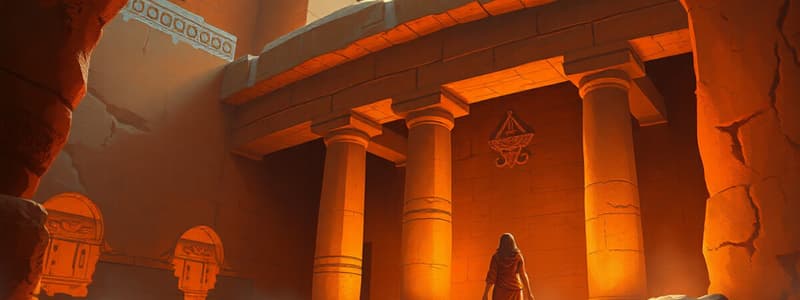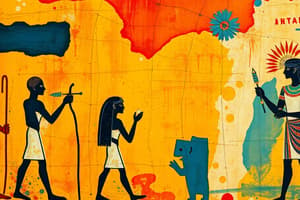Podcast
Questions and Answers
What materials are traditionally used in Chinese painting?
What materials are traditionally used in Chinese painting?
- Oil paints on wood panels
- Digital mediums
- Ink and brush on silk or paper (correct)
- Wood and canvas
What was the primary purpose of medieval art?
What was the primary purpose of medieval art?
- To educate and inspire religious devotion (correct)
- To depict realistic human forms
- To promote individual artists
- To reinforce political power
Which characteristic is NOT associated with the style of Ukiyo-e?
Which characteristic is NOT associated with the style of Ukiyo-e?
- Vibrant colors
- Bold lines
- Use of natural materials (correct)
- Perspective techniques
Which of the following media were commonly used in medieval art?
Which of the following media were commonly used in medieval art?
What is the purpose of Chinese painting?
What is the purpose of Chinese painting?
How did Augustus contribute to Roman arts?
How did Augustus contribute to Roman arts?
Which of the following is a notable figure in Chinese painting?
Which of the following is a notable figure in Chinese painting?
What does the term 'Ukiyo' mean in the context of Ukiyo-e?
What does the term 'Ukiyo' mean in the context of Ukiyo-e?
What characteristic distinguishes medieval art from other art movements?
What characteristic distinguishes medieval art from other art movements?
What technique do Ukiyo-e artists use to create color gradients?
What technique do Ukiyo-e artists use to create color gradients?
Which statement best describes the style of medieval paintings?
Which statement best describes the style of medieval paintings?
Which of the following subjects is commonly depicted in Ukiyo-e prints?
Which of the following subjects is commonly depicted in Ukiyo-e prints?
What name is given to the beautifully illustrated religious texts produced during medieval times?
What name is given to the beautifully illustrated religious texts produced during medieval times?
Which notable artwork is credited to the Limbourg brothers?
Which notable artwork is credited to the Limbourg brothers?
How did traditional Chinese painters strive to engage viewers with their art?
How did traditional Chinese painters strive to engage viewers with their art?
How does Asian art predominantly express cultural identity?
How does Asian art predominantly express cultural identity?
What defines an art movement?
What defines an art movement?
Which media were primarily used by artists in prehistoric cave art?
Which media were primarily used by artists in prehistoric cave art?
What was a likely purpose of cave art?
What was a likely purpose of cave art?
How did the hieratic scale function in Egyptian art?
How did the hieratic scale function in Egyptian art?
What is a key characteristic of figures in Egyptian art?
What is a key characteristic of figures in Egyptian art?
What materials did Egyptian artists NOT typically use?
What materials did Egyptian artists NOT typically use?
What represented fertility and rebirth in Egyptian art?
What represented fertility and rebirth in Egyptian art?
Why is individual attribution to artists not common in cave art?
Why is individual attribution to artists not common in cave art?
What was the significance of the Pyramid of Djoser in ancient Egyptian architecture?
What was the significance of the Pyramid of Djoser in ancient Egyptian architecture?
Which of the following best describes the purpose of Greek art?
Which of the following best describes the purpose of Greek art?
How did Roman art differ from Greek art in terms of style?
How did Roman art differ from Greek art in terms of style?
What characteristic is a defining trait of Greek sculpture?
What characteristic is a defining trait of Greek sculpture?
Which of the following media was NOT primarily used by Greek artists?
Which of the following media was NOT primarily used by Greek artists?
Who was Phidias and what was he renowned for?
Who was Phidias and what was he renowned for?
What architectural innovation was significant in Roman art and allowed for larger structures?
What architectural innovation was significant in Roman art and allowed for larger structures?
The significance of Imhotep in ancient Egypt is primarily related to which of the following?
The significance of Imhotep in ancient Egypt is primarily related to which of the following?
Flashcards
Art Movement
Art Movement
A collective name for a group of artworks that share a common style, philosophy, and technique.
Ancient Art
Ancient Art
Ancient art encompasses artistic creations from early civilizations, including Prehistoric and Classical periods.
Cave Art
Cave Art
Cave art, dating back roughly 40,000 years, represents the earliest known form of human art.
Media in Cave Art
Media in Cave Art
Signup and view all the flashcards
Styles in Cave Art
Styles in Cave Art
Signup and view all the flashcards
Egyptian Art
Egyptian Art
Signup and view all the flashcards
Media in Egyptian Art
Media in Egyptian Art
Signup and view all the flashcards
Hieratic Scale
Hieratic Scale
Signup and view all the flashcards
Roman Art's Purpose
Roman Art's Purpose
Signup and view all the flashcards
Augustus's Artistic Legacy
Augustus's Artistic Legacy
Signup and view all the flashcards
Medieval Art's Focus
Medieval Art's Focus
Signup and view all the flashcards
Medieval Art Style
Medieval Art Style
Signup and view all the flashcards
Medieval Art Media
Medieval Art Media
Signup and view all the flashcards
Purpose of Medieval Art
Purpose of Medieval Art
Signup and view all the flashcards
Asian Art's Essence
Asian Art's Essence
Signup and view all the flashcards
Chinese Painting's Focus
Chinese Painting's Focus
Signup and view all the flashcards
Pyramid of Djoser
Pyramid of Djoser
Signup and view all the flashcards
Naturalism in Greek Art
Naturalism in Greek Art
Signup and view all the flashcards
Contrapposto
Contrapposto
Signup and view all the flashcards
Portraiture in Roman Art
Portraiture in Roman Art
Signup and view all the flashcards
Frescoes in Roman Art
Frescoes in Roman Art
Signup and view all the flashcards
Realism in Roman Art
Realism in Roman Art
Signup and view all the flashcards
Egyptian Art & Afterlife
Egyptian Art & Afterlife
Signup and view all the flashcards
What are the main styles in Chinese painting?
What are the main styles in Chinese painting?
Signup and view all the flashcards
What is the purpose of Chinese painting?
What is the purpose of Chinese painting?
Signup and view all the flashcards
What medium is used in Ukiyo-e art?
What medium is used in Ukiyo-e art?
Signup and view all the flashcards
What are the key styles of Ukiyo-e?
What are the key styles of Ukiyo-e?
Signup and view all the flashcards
What is the main purpose of Ukiyo-e?
What is the main purpose of Ukiyo-e?
Signup and view all the flashcards
Who are some significant artists in Ukiyo-e?
Who are some significant artists in Ukiyo-e?
Signup and view all the flashcards
Study Notes
Ancient Art
- Ancient art encompasses creations from prehistoric times to classical antiquity
- Reflects human expression and cultural values
- Includes cave art, Egyptian art, and Greek and Roman art
Cave Art
- Dates back to around 40,000 years ago
- Marked the beginning of human art
- Examples include the Lascaux Cave in France
- Depicts animals, human figures, and abstract symbols
- Artists used natural pigments (ochre, charcoal, minerals) mixed with animal fats or water as media
- Utilized primitive tools (twigs, animal hair)
- Features simple forms, silhouettes, outlines, dynamic animals (bison, horses, deer) and hand stencils, geometric patterns
- Purpose likely related to hunting rituals and documenting significant events
- Individual artists unknown, but works reflect a collective cultural effort
Egyptian Art
- Flourished from 3000 BCE to 30 BCE
- Focused on the afterlife and honoring gods and pharaohs
- Key characteristics:
- Media: Stone, wood, metal, papyrus
- Styles: Hieratic scale (larger figures=higher status), frontal poses, heads/legs in profile, symbolism (colors/icons e.g., green = fertility)
- Purpose: Religious and funerary, for temples/tombs. Aiding deceased's journey to afterlife
- Significant Artists: Imhotep (architect of the Pyramid of Djoser, first large stone building)
Greek Art
- Influenced Western culture through emphasis on beauty, humanism, and idealized human forms
- Dates from 800 BCE to 30 BCE
- Key characteristics:
- Media: Marble, bronze, pottery (e.g., black-figure/red-figure pottery)
- Styles: Naturalism in sculpture, Contrapposto (lifelike figures with sense of movement/balance)
- Purpose: Celebrated human achievement, explored mythology, honored gods, often in public spaces/temples
Roman Art
- Dates from 500 BCE to 500 CE
- Adapted Greek influences, emphasizing realism and everyday life
- Key characteristics:
- Media: Marble, frescoes (wall paintings), mosaics (decorative flooring)
- Styles: Portraiture (capturing likeness/character), architectural innovations (arch, dome)
- Purpose: Convey power, commemorate achievements, reflect cultural values. Public monuments honored emperors/heroes
Medieval Art
- Dates from 500 to 1400 CE
- Deeply influenced by the church, focused on religious themes
- Key characteristics:
- Media: Illuminated manuscripts, stained glass windows, sculpture
- Styles: Flat, symbolic representations, bold outlines, colors over realistic proportions, stylized figures (prioritized spirituality over naturalism
- Purpose: To educate and inspire religious devotion
Chinese Painting
- Rooted in ancient traditions, emphasized harmony with nature & philosophical concepts
- Media: Ink & brush on silk/paper
- Styles: Landscape, calligraphy
- Purpose: To convey spiritual/philosophical ideas, essence of nature, emotions/ideas (harmony, balance, transient nature of life)
Ukiyo-e (Japanese Print)
- Emerged in Japan during the Edo period (1603-1868)
- Celebrated the beauty of everyday life, known as "pictures of the floating world"
- Key characteristics: Vibrant colors, bold lines, perspective, bokashi (color gradients)
- Media: Woodblock printing
- Purpose: To capture fleeting moments in landscapes, kabuki actors, beautiful people (bijin), and scenes from popular stories
Studying That Suits You
Use AI to generate personalized quizzes and flashcards to suit your learning preferences.




